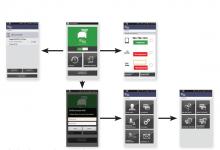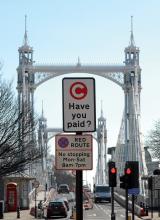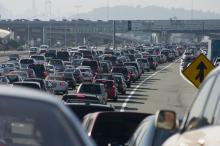
Q-Free’s Frank Kjelsli talks to Colin Sowman about why video tolling could be the boost to efficiency and interoperability the industry is seeking.
Like it or not, the principal of one person, one tolling account is likely to become a reality: be that in America with the 2016 interoperability deadline or the European EETS requirement. Multi-tag readers are being introduced and alliances are being formed to meet legislative requirements but as the debate continues about which systems and protocols to adopt, it appears deadlines will be missed.
But is the industry missing a trick - is there an easier way to achieve these aims? According to Frank Kjelsli, vice president of Managed Services at
“The tolling industry has evolved and is continuing to evolve. We moved from handing over cash to people sitting in booths to using toll tags to automatically trigger the barriers to rise. Now, toll operators globally are doing away with the barriers altogether and moving to free flow tolling to prevent congestion at the toll plazas.
In a comparison of ways to collect and process data from registered users, the overall cost of processing video transactions can be higher than for tags. However, there are capital and operational savings to be made if the system design takes the demands of video tolling into account, Kjelsli argues.
“While many free flow tolls utilise the toll tags, with any open road tolling system you have to install cameras to capture and charge vehicles that are not registered in the toll operator’s system. Even if the tag population exceeds 90% as it does in areas like Norway, there may still be 20 to 25% of transactions that have to be processed via video images.”
As the number of free flow toll operations grow, so do the image handling requirement as the need for video transactions are not only due to violators and non-registered vehicles. In Kjelsli’s experience many, often the majority, of video transactions are not related to violators but come from the misreading of the toll tags, caused by bad batteries, radio interference or something similar. Where violators are identified the tolling company may be able to levy an additional charge but it is difficult or even impossible to add any penalty for a misread so the value of the transaction remains the same to the toll company but the processing costs of image transactions are much higher than for tags.
Kjelsli says this becomes a burning issue for toll operators. “When 20 to 25% of your income is from video transactions and these transactions account for up to 40% of your operating costs, then executives really need to start looking at this issue.”
He believes one potential solution is to make video the primary tolling method and to design the system around that operating model. “Unlike tags where you might get an 80% or 90% penetration, every vehicle has a numberplate and we have found that imaging technology has improved to an extent that in Sweden we are seeing hit rates in the high 90%.”
The main reason the overall cost of processing video transactions can be higher than with tags is that manual labour must be required more frequently due to dirty, damaged or obscured numberplates. However, there are capital and operational savings to be made if the system is designed for video tolling, argues Kjelsli. Regarding the capital costs he reiterates that in a free-flow tolling system a camera system with video tolling capabilities is already a necessity for both enforcement reasons and to catch misreads.
As to the possible savings in operational costs he first highlights that there is no need to purchase, manage, maintain or distribute tags or onboard units (OBUs). “If a tag misread doesn’t impact the amount registered drivers pay, they are not too bothered about changing a defective tag. The toll operator may need to send several reminders to change the battery or replace the tag and this costs a lot of money. In the meantime, the vehicle’s registration number may have to be manually entered twice a day for several weeks.”
For such reasons, Kjelsli stresses that even where the decision is to go with a tag system, it is still important to take a holistic view of image processing and to include the requirements of video tolling when implementing an efficient tolling system.
“Even where a road authority opts for a tag-based system as the primary method of gathering users’ data, the fact is that down the path a good proportion of their revenue will still come from video-based tolling. If they have bought a camera system that does not provide good quality images it will be harder and more expensive to process those transactions because you can’t do them automatically. Many, potentially all, may have to be processed manually and if the image quality is bad then even that comes with challenges and could result in a higher proportion of violations and misreads becoming leakage with no change of collecting the revenue.
“Some toll operators tend to overlook this reality during the procurement process and only realise the consequence when operations start and they recognise how many transactions are coming in through the camera system,” he says.
At Q-Free Kjelsli says the experience is that camera technology is now so good that in some markets it can be cheaper to opt for video tolling; he cites Europe as an example because the numberplates are relatively standardised. But he is clear that video tolling is not a one-size-fits-all solution: “In very dense traffic then tags can be more accurate, snow or dirt on the licence plate can disrupt video tolling systems and the storage requirements for video are a lot higher than with tags. And you have to consider that if you do decide on video tolling then all your revenue is linked with the cameras rather than divided between the cameras and the tags, so system reliability becomes an even more crucial issue.”
His best advice is not to skimp on the budget for cameras and “if you decide to go for video tolling then go for the best cameras you can get.”
Video tolling also has the potential to overcome many of the interoperability problems the industry is facing – again because all vehicles have registration plates. In areas like America where there are numerous licence plates styles it can be easier for toll operators to add the appropriate libraries to their video tolling camera to read the required fonts than to agree communications protocols with other toll operators. “With the correct libraries, a video tolling system can read a variety of licence plate styles and identify in which state or country the vehicle is registered. The back office systems can then check if there is a tolling account registered to that vehicle and send an invoice either to the tolling company holding the account or to the individual.”
Looking further ahead he believes the operational efficiency of tolling agencies will increasingly be dictated by their ability to handle and process images and that some may outsource image handling to a third party under a service level agreement-based contract. This would not only minimise cost, leakage and billing errors, it could also fix a large proportion of the operator’s costs.
Kjelsli sums up by saying: “With the current direction of the tolling industry, this is the business case tolling companies need to consider carefully.”
EIP
Q-Free has developed an enhanced image processing system for reading numberplates. With this system, if the automatic system has difficulty reading the number it is referred for manual reading in the normal way and the clerk identifies and types in the number. In the EIP system the image and the correct number are stored in a database so if and when that same plate is picked up again, the system will automatically recognise it without the need for human intervention. It will do this every day all the year round rather the operator having to key the number in again and again. In essence the system provides feedback loop between humans and machines and its performance will improve over time.











